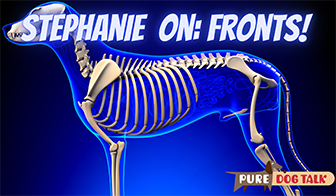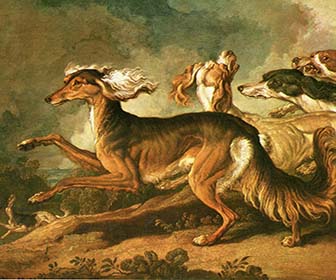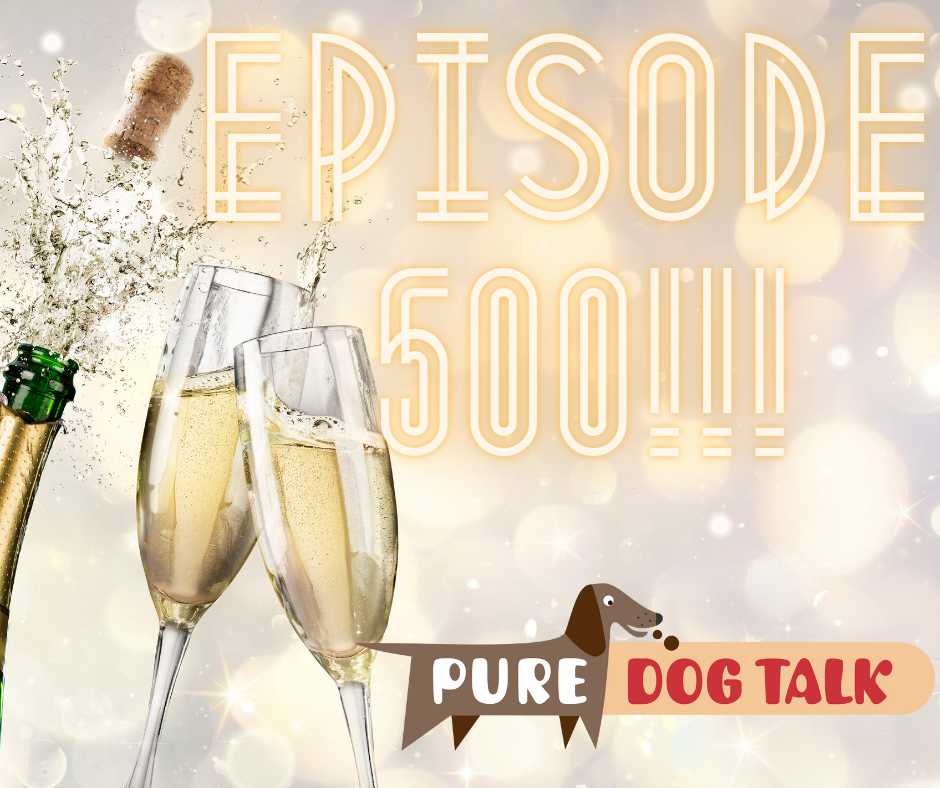505 – Front and Center with Stephanie Seabrook Hedgepath
Front and Center with Stephanie Seabrook Hedgepath
Stephanie Seabrook Hedgepath and host Laura Reeves are back, chasing squirrels and discussing the single most important part of canine structure and anatomy: the front assembly.
“If you have a bitch and her front assembly is not what you really want,” Hedgepath said, “what you gotta do is you gotta find a dog that has the front assembly you do want, which is not easy in any breed. The hardest thing to put on a dog’s that front assembly. Once you find dog, …when you do that breeding, don’t be taken in by that precious little beautiful face if it doesn’t have that front assembly you’re looking for.
“We all started somewhere. You have to work at it. You have to train your dog. You have to select the proper dog. You have to learn and know what you’re seeing. Some people get lucky and they get a magic wand and their first dog is a big time winner. Most of the rest of us work our (butts) off for a lot of years.
“Learn your history. Learn what your dog’s about, even if it’s a relatively modern dog and do not try to make it something that it isn’t.
“I’ve never been one that thought that movement and type were two different things. They’re the same thing, because every dog moves according to his type and how he’s put together. Movement is an integral part of type. Movement is actually the proof of structure.
“I mean let’s just say an Old English Sheepdog and its movement and a Bearded Collie and its movement. Both fuzzy dogs, long hair and they come from kinda the same areas and totally different breed type. They worked in different train and different styles of working.
“This is something I cannot say enough times, the work that a dog was designed to do informs the structure it has to do the job the people needed it to do to live. Whether it was to put meat on the table or to have meat to sell or to be a poacher or whatever, whatever it was kept the food on the table.
“We’re fortunate today that, yes, we can breed for pretty. But what good is it if it doesn’t still represent the breed it was supposed to be. The concept of preservation breeding is to preserve the dog. It was designed to do the job, even if it doesn’t still do the job, it should be able to do so.”
In summary, front assemblies are important. They are different between types of dogs based on the work the dog was bred to do. If you are breeding dogs and looking to create better front assemblies, you have to select for the puppy that has the correct front assembly when you evaluate the litter. Once you’ve selected a good front, you have to train the dog so that the judge can actually see the movement that proves the structure.
For more episodes around this topic check out here and here.
504 – Dog Trainers and Dog Breeders Working Together
Dog Trainers and Dog Breeders Working Together

Kayley Paylor and her Azawakh.
Kayley Paylor, like many professional dog trainers, started in her profession after acquiring a rescue dog that had issues. She became a huge advocate for the predictability and reliability of well-bred purebred dogs as a result. Paylor joins host Laura Reeves to tackle the “elephant in the room” when it comes to dog breeders and dog trainers working together.
“It’s one of those issues where you don’t even realize that that type of (animal rights) agenda is sneaking in because the line between animal welfare and animal rights activists is a tough one,” Paylor said. “People who love their dogs and want the best for their dogs and trainers who want the best for dogs, it’s really easy to lose track of what is actually best for them in the long term. Are we going to let them suffer with mental issues when we could just clarify the issue immediately with a consequence once that is appropriate.
“So, what I tend to see and what I ran into is, again, really well-intentioned individuals who get a rescue as their first dog. Mine had health problems, as is unfortunately common, and I didn’t know that going into it. Epilepsy, dental issues, that type of thing. And some behavioral issues that come with, certainly, genetic temperament issues, but also just they didn’t have a breeder that cared about the puppy, that gave them the solid foundation.
“I dug into the behavioral issues and what I started to see, when I went through my apprenticeship, … I saw all of these incredible women who had these purebred dogs that were predictable. That you could understand exactly what was going to happen. And so I started to understand ‘oh, OK, you understand exactly what you’re going to get when you get that dog.’ I was lucky and I wasn’t the only one. All of my colleagues that came in at the same time as I did all came from a rescue background.
“All of my colleagues went that way, where we started with rescues and ended up with purebred dogs. Because if you rescue dogs, you have to understand you’re not getting anything predictable. You don’t know the background.
“From a breeder perspective, I do wish that breeders had a little bit more trust in trainers … but it’s just a breakdown in communication. Neither of them see all the good that the other one can do because of the bad in both communities.
“It’s just about getting those well-bred dogs in front of trainers. Even if you know what you’re doing. Even if you think you know what you’re doing, taking them to a puppy group class for puppy play.
“On both sides of the issue let’s just say R+ versus a balanced perspective, you’re going to get people who understand dogs and their different needs and their different drives, and you’re going to get people who don’t.”
Listen to the entire episode above and hear Paylor’s insights on finding a good fit for a trainer to work with, training insights and so much more.
503 – Examining the History of Sighthounds with Bo Bengtson
Examining the History of Sighthounds with Bo Bengtson
Bo Bengtson, author, publisher and Whippet breeder, attended his first dog show in 1958 in his native Sweden. He joins host Laura Reeves for a deep dive into the intricacies of sighthounds.
“It was, right away, like lightning struck,” Bengtson said. “I was 14 years old and I just knew right away that this was what I wanted to devote my life to. It was really fascinating. It was, as someone once said, a combination of zoo and circus and theater …
A passion for sighthounds
“You have to know a little bit about coursing if you’re involved in sighthounds. They have remained the same for thousands of years, the basic type. They weren’t breeds early on but different types of sighthounds. if you look at the early description of coursing which is the pursuit of game with sighthounds … that is a sport that’s now these days illegal in most of US… It’s been superseded by lure coursing, which is an artificial form of coursing.

“Hunters Homeward Bound,” 10th Century AD. Courtesy of Bo Bengston.
“(Sighthounds developed) before firearms basically, when the only way you had to hunt was through the dogs and whatever they could course and kill was basically today’s dinner. Firearms made sighthounds very much superfluous. And I think the sport then became very much a status symbol. (Sighthounds) are of course aesthetically pleasing and so many rich people and aristocratic people preferred to hunt with sighthounds, not because of need but because it was a beautiful spectacle and pretty expensive spectacle too. In various parts of the world, Queen Elizabeth I was very fond of coursing. In Russia they coursed with Borzoi. And in the Far East there were Salukis.
What IS a Sighthound?
“There is no official definition of what a sighthound is. So there is a great disagreement about what breeds actually count as sighthounds. You can count as few as four or five as pure sighthounds and as many as 40 as “sighthound related” or different types of breeds we don’t know in this country. Some we wouldn’t define as breeds but more as types.
(Listen to fascinating conversations about the Caravan Hounds of India here and here.)
History of sighthound development
“I think we have to go back again a couple of thousand years because there have probably always been different sizes of greyhounds. Greyhound types. The big ones which were the ancestor of the modern greyhound. And we have the different, smaller ones that were ancestors of whippet and the Italian greyhounds. I think that Whippets, although they weren’t described as a breed until late 1800s, they have certainly been around much longer. Catherine the Great of Russia had little English greyhounds she called them. And they were very important to her. She nursed them herself and they slept on a pink couch in her bedroom. But whether they’re Italian greyhounds, whether they were whippet, who knows. I mean they were very small and whether Italian greyhounds or whippets, it is kind of irrelevant these days.
“The Greyhound and the Saluki are sort of the “ur” sighthound, what sighthounds are supposed to be like. … if you take one step away from Saluki you get the Afghan Hound, which is a little more powerful. If you take several steps away from the Greyhound, you get the Ibizan Hound and you get the Portuguese Podengo and that kind of thing.”
Listen to the full episode for more detailed insights into all things sighthound.
502 – Seizures in Dogs: Causes, Treatments and Considerations
Seizures in Dogs: Causes, Treatments and Considerations
Dr. Marty Greer joins host Laura Reeves for this month’s Veterinary Voice talking about seizures in dogs. Type of seizure, age of onset, causes and treatments are all up for discussion today.
“Seizures can be actually epilepsy, which has probably got a genetic component to it,” Greer said. “Where the dog has an epileptic tendency. Typically those are going to be seen in certain breeds of dogs and they typically happen between two and four years of age for the first seizure. If we’re seeing seizures or seizure type activity or episodes in really young dogs or dogs that are elderly, it’s probably not primarily an epileptic situation.
“If it’s a very young puppy, the first thing we look at is blood glucose. If their glucose drops because they’re not eating adequately, they don’t have enough glycogen stores in their liver, and so they’re weak or they’re sick, they’ll have a seizure type of activity. So, the first thing we do in anything that’s really young or really old, is reach for some kind of glucose. You can reach your Karo syrup, you can reach for honey. If you have caramels and the dog is capable of chewing them, that’s great. You can give sweetened condensed milk. Glucose can be absorbed right through the gums, so the dog doesn’t actually have to swallow to get the effect of bringing up their glucose.
“If you have an older dog (with seizure activity) the first thing to do is get some initial blood work. That’s easy to do. You can check calcium, you can check glucose. It’s easiest and most effective to check it very close to the time of the event. Glucose can go down for multiple reasons. I’ve seen it go down during severe pregnancy toxicosis. I’ve seen it go down because dogs have eaten xylitol, sugarless gum and candy. And I’ve seen it go down because dogs have insulinomas, which is a tumor in the pancreas. Those are functional tumors that create so much insulin that the dog’s blood glucose drops precipitously. Anytime your glucose is too low you can have a seizure. I’ve also seen it go down in Addison’s disease.
“You want to be sure that you’re comprehensive and complete on what’s going on with the dog before you jump to any conclusions. There’s always the toxins. So, xylitol we’ve talked about as a possible toxin, but there are some rat poisons and some other neurotoxins that we can see not the vitamin K type of rat poison. There’s a lot of other kind of nasty toxins that are out there that dogs can sometimes get into. Sometimes our pharmaceutical medications can cause that as well, so appetite suppressants can cause it, there are a number of different drugs on the market that can cause seizure type of activities. It’s really important that we get a good history on these drugs what they might have gotten into.
“The other thing to know is that the new class of oral flea and tick medications can cause neurologic disease tremors. That can also include seizures in seizure prone dogs. If your dog recently had a dose of that, typically within 24 hours, you need to include that too. So you need to go through the list of anything that’s possible, anything that’s the dog was given deliberately or not deliberately so that we are not missing any information that could potentially be a problem.
“Of course, in the older dog, there are structural abnormalities like brain tumors. That’s diagnosed with either CT scan or an MRI … there’s a lot of things that make dogs look like seizures, but it’s not always epilepsy. Epilepsy is a diagnosis of exclusion. Typically, we diagnose it after everything else has been ruled out.”
Listen in to the podcast for Dr. Greer’s suggestions on treatment plans and more.
And go back to Liz Hansen‘s conversation on the research in this area.
“The Rest of the Story” — From Craigslist to Number One Field Spaniel
“The Rest of the Story” — From Craigslist to Number One Field Spaniel
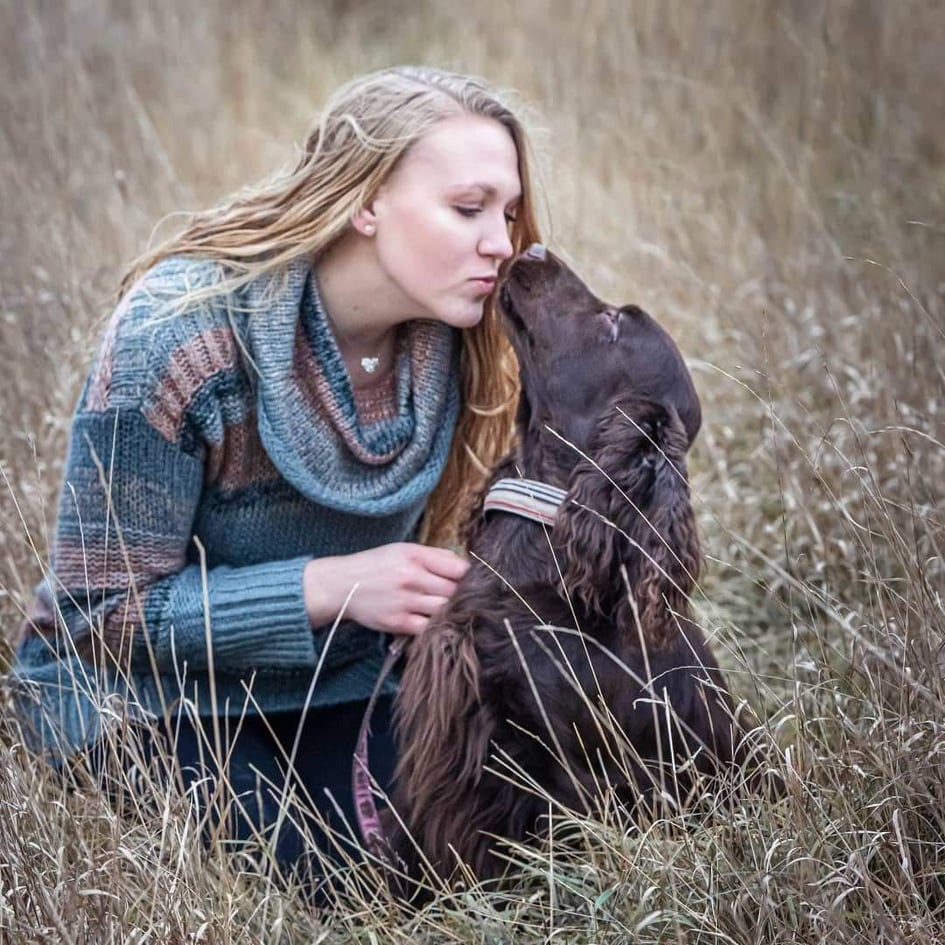 Mikala Seymour and her Field Spaniel, Riley, are an impressive team. Riley, GCHB CH Bruce’s Living the Life @ Upland, is currently the number one field spaniel all-systems and a national specialty winner, entirely owner-handled. This is a significant accomplishment for anyone. But “the rest of the story” is the impressive part.
Mikala Seymour and her Field Spaniel, Riley, are an impressive team. Riley, GCHB CH Bruce’s Living the Life @ Upland, is currently the number one field spaniel all-systems and a national specialty winner, entirely owner-handled. This is a significant accomplishment for anyone. But “the rest of the story” is the impressive part.
Mikala just turned 18 years old. And Riley came to her through Craigslist, as a three year old. A junior handler and a backyard dog teaming up to successfully take on the dog show world is not an everyday occurrence.
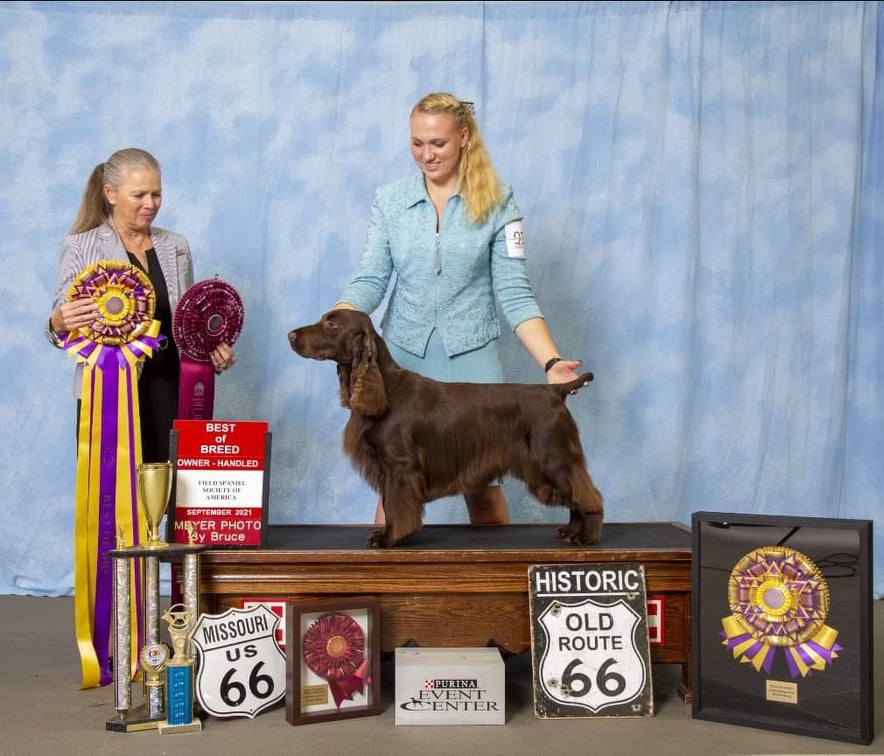 “He was actually found for sale on Craigslist by my mentor,” Mikala said. “He was down in Texas. Three people piled together and were able to get him up here. My mentor when she finally got him had a table with her. She put him on the table, racked him up and said ‘underneath this mess of a dog’ ’cause his fur was matted and disgusting ‘there’s a really nice dog under here. I think it needs Mikala’s touch’ pretty much is what she said. She ended up cleaning him up a little bit and shipping to me. That’s when I started putting in the hard work. I had to teach him how to run, I had to teach myself how to groom. It was a good almost year of learning for me and we created a special bond and we’ve just gone from there.
“He was actually found for sale on Craigslist by my mentor,” Mikala said. “He was down in Texas. Three people piled together and were able to get him up here. My mentor when she finally got him had a table with her. She put him on the table, racked him up and said ‘underneath this mess of a dog’ ’cause his fur was matted and disgusting ‘there’s a really nice dog under here. I think it needs Mikala’s touch’ pretty much is what she said. She ended up cleaning him up a little bit and shipping to me. That’s when I started putting in the hard work. I had to teach him how to run, I had to teach myself how to groom. It was a good almost year of learning for me and we created a special bond and we’ve just gone from there.
“He was pretty much someone’s pet that they barely did anything with. They barely socialized him or anything. But he is the sweetest little thing. He just wants attention and he’s done so much for me. He’s learned to tolerate a lot too, with the grooming and stuff. He wasn’t too happy about it at first, but once he figured it out, he’s getting to be good with it now.
“I’m actually third generation with this. We started in Saints. I started showing Saints as well in juniors and in the bred ring. (That’s) the breed that I fell in love with. It made me want to continue doing this. And then somebody said I should try a sporting dogs to be a little more flashy over the big drooly Saint, so we tried that and it just kind of snowballed from there.”
Mikala offered her top three tips for anyone who wants to be successful with their dog in the ring:
- Find what makes your dog click. Get inside their head. “Learn what makes your dog special and get that connection with them so that they want to please you.”
- Always talk to people. Learn more about your breed. Learn about other breeds. Get advice from other people with your breed. “Learn from them and take everything with a grain of salt ’cause everyone’s gonna have a different opinion. You have to do what’s right by your dog, while still listening to their advice and thinking about ‘is this gonna work for my dog or can I use this tip but do it in a different way, so it works better for my dog’ kind of a thing.”
- Just have fun with it and do your best. As long as you’re having fun, you can’t go wrong.
Episode 500!!! Celebration of Pure Dog Talk!
Episode 500!!! Celebration of Pure Dog Talk!
Welcome to Pure Dog Talk! I am your host Laura Reeves…..
These words hit the airwaves for the first time almost exactly five years ago … Five HUNDRED times later, I still have to think about my tone and cadence and inflection. Maybe just a bit less these days lol… Sort of like you guys learning to show your dog, I am entirely self-taught how to do this job and I am eternally grateful that you all have joined me in what has been a pretty incredible journey.
Today’s episode is a pure cork popping, champagne swilling celebration of our tribe. YOU guys shared some amazing stories about how this show has impacted your life in dogs. I dug around and pulled out some of MY favorite guests and interview moments.
Pure Dog Talk is not and never has been *static.* It lives and grows, often faster than I can keep up! As we move forward in the coming years, there will be changes, of course. For example, I’ll once again be podcasting *exclusively* on Pure Dog Talk. I’ve stepped waaaay outside my comfort zone and will be offering more Facebook Live and Webinar opportunities here at Pure Dog Talk (like the K9 First Aid 911 series with Marty Greer that is available on the website now) as well as moving back to more of the pre-pandemic live seminars and panel discussions over the course of the coming year.
But mostly, I wanted to say thank you. To ALL of you. My listeners, my guests, my patrons, my sponsors, my supporters and even the best compliment of all, my competitors. You have all made me better at this role than I could have ever dreamed of being. My goal of offering meaningful education, FOR FREE, to as many people in our sport as I could possibly reach has absolutely come to pass.
Thank you for taking me with you on your drives, your workouts, even your lawn mower… I am deeply honored to keep you company while you bathe, trim, condition and clean up after your dogs. Thank you for caring, so very much, about your dogs, your breeding programs and the sport of purebred dogs. Without your single-minded dedication, they would all cease to exist.
Following are just a few of the hundreds of Stories of impact from our listeners:
Diane Davis
I first heard about Pure Dog Talk when something came across FaceBook about a handler friend of mine being interviewed about the Professional Handlers Association and how to hire a professional handler to show your dog. I listened to the episode and thought it was well done, so I decided to try listening to a few more. I was pleased to discover that these were also well done and informative. I have about a forty-minute commute to work so I began to listen while driving back and forth. It wasn’t long before I got caught up on the episodes that I thought would be interesting. But as I started to go through some of the others, what I discovered was that I learned something from every episode. I began to look forward to the new episodes coming out and would listen to them several times so I didn’t miss anything.
Pure Dog Talk has become a big part of my life. I love learning about other breeds. The episode about the Bracco Italiano brought back a memory of the Bracco Axel floating around the ring to win the World Challenge Cup at Eukanuba the year I was there. I loved hearing about judges. As an owner-handler I always felt that judges were kind of unapproachable, but the interviews helped me to see that they were people too. Veterinary Voice with Dr. Marty Greer was invaluable. The episode on pyometra gave me the tools to advocate for my girl with my vet when she developed pyometra on her first heat cycle. We were able to medically manage her condition and she has since had two litters. And speaking of puppies, Pure Dog Talk has taught me a lot about breeding, whelping and raising puppies. I hadn’t bred a litter in nearly seven years because my last litter had been so hard, but with new knowledge, and new resources I have bred and raised two litters this year.
Then 2020 happened. Covid19 happened. Dog shows disappeared from the Pacific Northwest for over six months. Uncertainty about health, finances, family, friends was ever present in everyone’s life. But through it all, the Pure Dog Talk podcast was one of the few things that was stable. The Patrons “After Dark” was created so once a month we could meet via Zoom and talk about dogs, have an adult beverage and feel somewhat normal. When we had the first retreat in Montana in September 2020, we realized we had created a wonderful community of dog people and a “safe space” for everyone involved. The virtual dog shows were fun and a way to participate in some small way, a dog show. I know that I speak for other as well when I say these activities helped keep me sane during that crazy year.
As everyone in dogs knows, things are never easy. There are disappointments and body blows. There are emergencies, vet bills, money issues and just plain exhaustion. But the Pure Dog Talk podcast seems to have uncanny timing and usually is talking about a subject that I need to hear about when I need to hear it. And when I look into the eyes of my dogs, it is all worth it. I wouldn’t trade them or my life with them for anything. When you know better, you do better. Thanks Pure Dog Talk for everything you’ve given me and my dogs.
I’m Tracey Rives, Montgomery, AL, a breeder/owner/handler of Havanese dogs.. I just recently discovered your podcast “Pure Dog Talk “. Your recent podcast with Amanda Kelly, Parts 1 and 2, sparked a fire in me as an owner handler and my journey for showing dogs. It was so inspirational for me. As an owner handler I crave information in every way and your podcast is priceless in supplying great unbiased information. My goal is to encourage breeders/owners to learn to handle their own dogs. I’m afraid it’s becoming a lost art. Showing my bred-by dogs to their championship is one of the top five most gratifying things I’ve done.
MY STORY: I took my bred-by boy, Manny, (18 months old, not even a grand yet) to our Havanese National Specialty in Orlando, FL, 2016 with my buddies “Southern Magnolia Kennel Club”. Our second National. Totally no expectations whatsoever – zero, zip, nada, nothing. Really the goal was to rub shoulders with the best of the best and learn, learn, learn – not to mention drink wine and dine and fellowship with my favorite peeps. I found myself in the ring with 36 or so of the best Havanese dogs (not including bitches) in the country. Made the first cut. Wow!! Ok. Went back in. Made the second cut. Holy shit! Ok. We won the whole damn thing!!! That did not just happen. My exact words to my husband when I called him immediately after the win when apparently I should have been first in line getting our win photo. Who knew?? LOL!! By default, I opted to be the last in the photo line. Just had too many friends to hug. It’s still surreal to this day.
So the reason I’m submitting this is looking back over the last several years as a “hobby” breeder/owner/handler of Havanese, it’s really about learning to run the race gracefully. Win or lose, for me it’s about sharing my passion with my people. Because seriously, at the end of the day, without the sweet memories, it would be just another dog show.
Kayley Paylor:
I started in conformation at the request of my boy’s breeder. An Azawakh is far from the easiest dog to start with, sighthounds with guarding instincts aren’t exactly the easiest dog to convince to stand for exam. We took handling classes, debuted in the ring before the breed had been fully AKC recognized, and he took Best in Miscellaneous. We showed again a few weekends later and my boy had suddenly hit adolescence, his guarding instincts were developing, and he wanted nothing to do with the judge. We muddled along for the next two years with varying degrees of success.
During that time I have the distinct memory of having drinks with a good friend who had started showing the same weekend I had. We were taking about show dogs and she recommended a podcast called Pure Dog Talk that she’d discovered. I wasn’t really the podcast type but I decided to give it a shot. I started putting it on on the commute to work and driving to and from shows and trials.
The very first episodes I listened to were the three part Bill Shelton episodes on building a family of dogs. In the intervening time since I’d brought home my first show and performance dog, I’d added a foundation bitch who I had chosen because her pedigree complemented my boys, she had beautiful drive and focus, and her structure at 8 weeks was again complimentary to my dog’s. Listening to Bill Shelton talk about developing two bitch lines that you can work between solidified the idea I’d had bouncing around in the back of my brain of adding a second bitch. Four months later I lucked into adding a perfect second bitch from completely different lines but complimentary to my male on different ways.
Since then Pure Dog Talk has been integrally woven into my life. I travel often both for my work as a dog trainer and for shows and performance events. Over the past two years I’ve driven more miles than I care to count. Pure Dog Talk was there for all of it. I’ve listened to Dr. Marty Greer give whelping advice on my way to Open Field Coursing, I’ve listened to experts like Dr. Gayle Watkins, Bill Shelton, Dr. Teresa Nesbitt, and so many more give advice and valuable insight on a dizzying array of topics on my way to everything from Royal Canin to UKC Premier to LGRA straight racing, lure coursing, and agility trials. And through it all the one constant: Laura Reeves’ dulcet voice guiding us through preconceptions, prejudices, and recording this information for the history books.
I grew up playing team sports and having a strong community is both revitalizing to me and so useful as a sounding board. That is what Laura has built with Pure Dog Talk: a community, a tribe as she often calls it.
I can go to the patrons group with any questions and not be judged for them. I have always struggled with confidence handling my dogs in the show ring. I don’t normally have stage fright at performance events but I would just get into the show ring and shake, which of course affected my dogs. But after the mock show at last summer’s retreat where my COVID Azawakh puppy showed very well, I left the retreat finally confident that I was supporting my dogs and presenting them to the absolute best of my ability. And when my car failed at the patrons get together this March, Laura graciously made room for my dogs so they didn’t have to sit in the cold car while I waited for a tow truck. That is what true community is about. That is how we keep people new to our sport around.
In many ways Pure Dog has been an instrumental resource for me over the last couple of years, not just for the handling tips but also the whelping information as I get ready to whelp my first litter. Pure Dog Talk is an invaluable resource for the purebred dog community and I’m eternally grateful to Laura for undertaking this podcast and for other listeners and patrons for supporting it and helping it become the resource it is today.
Christina Rozema
I wanted to give you another thank you update. Your podcast supported me showing my bull terrier bitch Freyja and with the wackiness of 2020 she became the top Bull Terrier in Canada. Sure there were ‘t many shows but there weren’t many for everybody equally. Then as I binge listened time-out breeding podcasts with Dr Greer and with Avidog, I planned her breeding with frozen semen imported from Poland to an amazingly successful litter of 11 who are now 3 weeks old.
You helped me build my courage, keep up my spirits, and feel confident enough to go ahead with her breeding.
Thank you thank you thank you. You have made such a difference in my life and the life of my dogs. I just wanted you to know.
Feedback from you guys gives me courage when things are tough to keep going. I am so grateful for our tribe.
So now, just a few comments from some of MY favorite guests and conversations over the last five years….
…..
There are so many more moments, episodes and conversations to be had. Watch this space! The next five years are guaranteed to be chockablock with knowledge shared.
498 – Stephanie Seabrook Hedgepath on Structure
Stephanie Seabrook Hedgepath on Structure
 AKC judge, Pembroke Welsh Corgi breeder, author and speaker Stephanie Seabrook Hedgepath joins host Laura Reeves for a conversation about canine structure. Hedgepath walks us through what’s important when evaluating a dog’s structure.
AKC judge, Pembroke Welsh Corgi breeder, author and speaker Stephanie Seabrook Hedgepath joins host Laura Reeves for a conversation about canine structure. Hedgepath walks us through what’s important when evaluating a dog’s structure.
“You gotta know where to put your hands,” Hedgepath said. “You’ve got to understand the skeletal structure of the dog because that’s the basis of the whole thing. Now a skeleton by itself can’t move. It’s gotta have muscles and ligaments and all of that, but you’ve got to understand the basics underneath … you also have to understand balance.
“That front assembly is laid back, set under the ribbing so as to provide the most support in the front when it acts as a shock protector … I think what people don’t understand is the whole front assembly of the dog is held on with muscles and ligaments to the chest. In the rear we have the hip the pelvis is fused to the spine at the sacroiliac joint. It is fused to the spine and then you’ve got a nice big ball and socket that goes into that. So that is much more rigid. The front assembly, if you don’t keep your dog in shape, they can get injured very easily. But if it isn’t set up properly and those muscles and all are not going where they need to go to hold all of that together, then we’ve got a big problem.
“I think that’s the thing that the majority people don’t understand. That’s why (when) dogs are in motion we can have dogs that flip their fronts, they paddle, they go in circles…. (while) in the rear, we don’t have as many different ways for the dog to go laterally, ’cause it’s a much more fixed assembly.
“What fascinates me is the way everything works together. Anatomy and Physiology is just beyond explanation sometimes because it’s like dominoes. If one little thing goes wrong then boom boom boom boom all the way down the chain everything’s gone.”
499 – Tips, Suggestions and Ideas for Growing Clubs
Tips, Suggestions and Ideas for Growing Clubs
Pure Dog Talk Patrons join in a roundtable discussion of “how do we grow our clubs.” How do we bring the energy and enthusiasm of new members and combine it with the knowledge and experience of long-term members to make something good that grows. Recorded live at Bonneville Basin Kennel Association in Farmington, Utah.
Outtakes
- “Cute kids and puppies sell newspapers. Get the media here. Get the media here talking about the great thing the dog shows are. It’s a family event. My kids are here doing this instead of off doing something sketchy.”
- Meet the breeds at the mall, Responsible Dog Ownership Days, school presentations and involving the club in the local community activities
- “Our dogs are our gifts to us and if we could only give the humans in our world the grace and the kindness and the forgiveness that our dogs give us every single day…”
- “We’re all trying our very best. If someone accidentally does something that might hurt your feelings, they didn’t do it on purpose. Be kind, say OK and go about your business. Every moment in time is not drama … everybody’s trying to do their best. I just so frustrated with the way we treat each other.
- “If you go to the club and say, ‘hey this is a great idea, you guys should do this,’ club leadership will likely balk. If you come to the club and say, ‘hey guys, I’ve got some amazing idea and I’ve got this entire six-page plan and my staff and this is how I’m going to manage it and this is what I’m going to do and I’m going to make you money while I’m at,’ the clubs be like ‘alright, go for it.’”
- “I’m hearing give grace. I’m hearing kindness. I’m hearing be willing to volunteer your time not just give other people bright ideas. I’m hearing ‘we’re not curing world peace at the dog show.’ Let’s be nice to each other. Mutual respect, participation, support, working in the community, building local communications.”
497 – Vet Voice: OTC and Home Remedies for Common Ailments
Vet Voice: OTC and Home Remedies for Common Ailments
Dr. Marty Greer, DVM joins host Laura Reeves for a prequel to our upcoming 6-week K9 First Aid 911 course. Greer covers what you CAN use, what you CANNOT use, when and how to use what.
Greer’s first reminder is that yes, vets are as swamped and over-booked as they claim. Be nice to the people in the practice! A little grace goes a long way.
“Often our staff isn’t getting lunch. They may not be leaving on time for dinner. So they are stressed, they’re overworked, they’re tired. And it may be as much emotional as it is physical stress and exhaustion. So be super nice to them, because they are wearing themselves out trying to make sure that no dog gets left behind.”
Secondly, “Dr. Google” is not always your friend.
“I think there’s a lot of misconceptions,” Greer said. “People look online and they read things and “Dr Google” and all the other places and sometimes those aren’t really reliable sources.”
Greer works her way through over the counter medicines that are safe and those that aren’t.
Safe and NOT Safe
Not safe includes any product containing xylitol, ibuprofen and Tylenol. Safe includes Benadryl, Robitussin DM, Pepcid, Bonine (motion sickness) and GasX.
Foxtails and managing dogs that swallowed sharp objects are topics we revisit from an earlier PureDogTalk episode here.
Anyone interested in learning more from Dr. Greer on these topics visit www.puredogtalk.com and sign up directly on the webpage for the webinar series “K9 First Aid 911.”
K9 First Aid 911
We all know that the pandemic and unending strain of hundreds of thousands of new pets has brought veterinarians and their staff to the breaking point.
Dr. Marty Greer, DVM and I wanted to do something to help.
Pure Dog Talk is THRILLED to host a series of six first aid courses taught by Marty Greer. She’ll cover what you can do at home, what you should have on hand and what YOU can do for your dog’s health. She’ll also talk about how to identify life-threatening emergencies and how to communicate those to your veterinarians.
And we’re doing our part to support all veterinarians by donating 50 percent of the proceeds of these courses to Not One More Vet to support the veterinary professionals who help our pets every day.
496 — Owner Handlers: Make a Plan, Manage Expectations
Owner Handlers: Make a Plan, Manage Expectations
Amanda Kelly of Fwaggle Toy Manchester Terriers joins host Laura Reeves for some final thoughts on Owner Handlers and how they can earn the advantage in the ring.
Have Fun
“There is nothing more eye catching than looking in the ring and seeing a dog that is having a good time and a handler having a good time. Maybe the dog isn’t standing perfectly. Maybe it’s got one foot out in the wrong place or whatever. I guarantee you that if that dog is having a good time it has better posture, he has better expression, it’s holding its shape and its outline regardless of whether every foot is where it needs to be it is a more attractive dog to look at then the perfect statue at the end of the line.
Take a Video
“It is so imperative that you see yourself, because showing dogs is just about making pictures. That’s all that we do when we go in the ring. We make a picture on this mat and then we make a hopefully nice picture as we move around the ring and then we get on the table and we make another picture and then we do the down back we make another picture. And in all those photos the handler’s job is to frame the artwork that is the dog but you don’t know what that picture looks like if no one’s ever shown you.
Make the Picture
“I think that one of the best ways of figuring out what picture you want to make in the ring is to choose handlers who present dogs in a way that you appreciate. You can do that really easily. Start with Westminster videos or maybe your national video. Watch it. Pick out someone who you think is the whole package and then look at what they’re doing, what are the little detailed pieces that make the difference in your mind.
Make it Muscle Memory
“The entirety of learning how to handle (is to move) from worrying about one thing to worrying about the next thing, because you’ve mastered the other thing that you used to worry about. Now you don’t think about it anymore. I can tell you I’ve shown my breed 35 years. I still have a thought process when I’m in there, but I’m not thinking about my lead. I’m thinking about things like when is the judge watching the dogs in the lineup and how do I stand so that I have the right angle, showing the profile that I want to show or how do I get this dog to stop shivering because it’s so cold.
YOU Can Do It
“Every single day at every show across America, across the world, people like me, people like you, people like those who are listening, are successful. You just have to make a plan. Learn manage your expectations so that you’re picking goals that work and are realistic. I would encourage you to go one step further and make sure that the goals that you set for yourself are achievable goals that have nothing to do with who the judge points to. If your only measure of success is whether or not you won a point or whatever, you’re doomed. You are doomed. If your measure of success is ‘I want to go in that ring and I want my dog to do X or I want to remember to hold my elbow in against my body and not have it flail around, whatever it may be. It needs to be something that’s within your control. I guarantee you that if you go at it with that attitude and you adjust your idea of winning and losing, you will have more fun. And if you have more fun you will win more.

